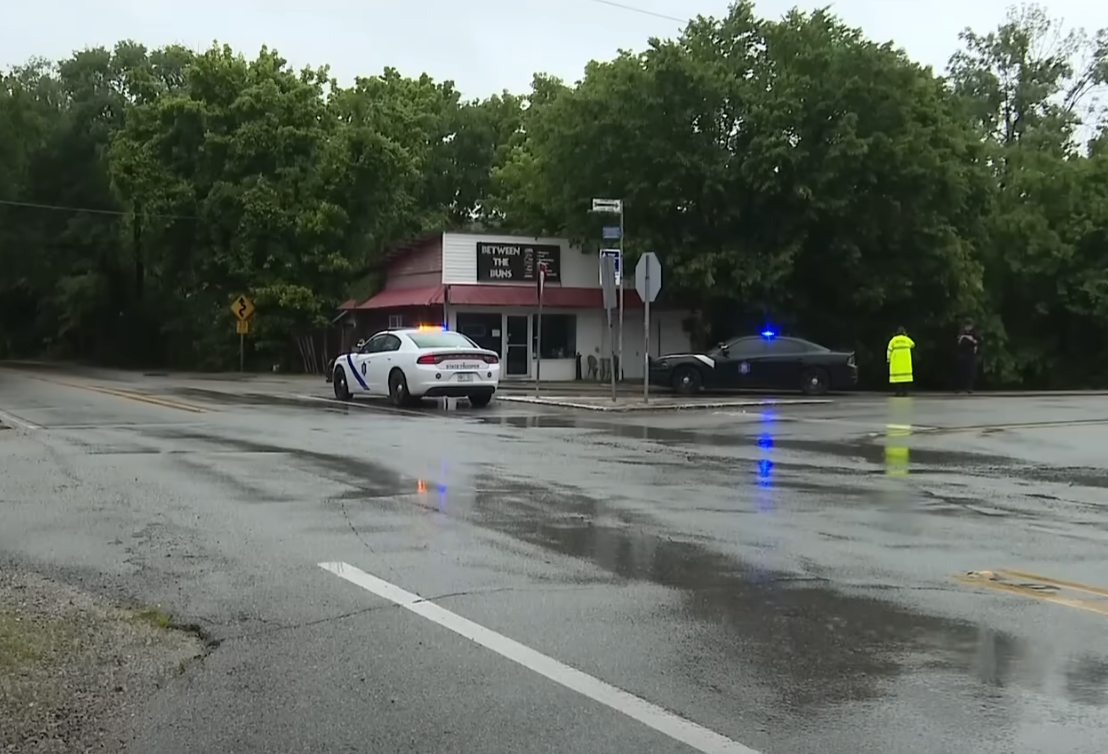
Gripped with fear, residents of a small Arkansas community are locking their doors and looking over their shoulders as a massive manhunt continues for a convicted rapist and killer who escaped from prison earlier this week and now is suspected to be hiding in a network of hidden caves in the Ozark Mountains.
Known as the “Devil in the Ozarks” after a HBO documentary about him, Grant Hardin lived a double life as a police chief of a small town until he was later convicted for murder and rape in 2018.
He pled guilty to murder after fatally shooting Gateway City water employee James Appleton in 2017 in his car, shortly after Appleton filed a police complaint accusing an officer of speeding.
Hardin’s DNA from the murder scene was later traced to a 20-year cold case of the rape of elementary teacher Amy Harrison at gunpoint in 1997.
Both crimes sent Hardin to prison for decades. Nathan Smith, the former Benton County prosecutor who helped put Hardin behind bars, told KHBS he is "a sociopath."

"He has no moral core or center that would prevent him from doing anything," he added.
Now authorities believe Hardin is hiding somewhere in the caves of the Ozark wilderness, after escaping the North Central Unit Correctional Facility in Calico Rock.
The escape resembled a movie plot: the 56-year-old wore a “makeshift” law enforcement uniform of a black baseball cap and black shirt, fooling everyone as he strolled past a prison guard on Sunday and headed out into the rugged terrain of the Ozarks.
Pretending to be law enforcement makes sense — Hardin was the former police chief in the small town of Gateway, near the Arkansas-Missouri border, before his arrest.
Now, Hardin has disappeared into the vast wilderness of an area he knows well. Officials say there are plenty of hideouts for someone on the run, from abandoned cabins to campsites to a network of hundreds of subterranean caves.
Hardin grew up in Northwest Arkansas with similar terrain, and spent his adult life in the towns around the Ozarks. That insider knowledge of the landscape makes authorities even more concerned about finding him.
As they scour the region for a fourth day in a row, Stone County Sheriff Brandon Long warned the public to be on alert and that Hardin is “extremely dangerous”.
The big escape
On Sunday, Hardin walked straight out of the medium-security prison, where he normally was detained in the maximum-security wing. He escaped through a sally port, a controlled entry or exit area at the facility, by wearing a “makeshift outfit designed to mimic law enforcement,” according to the Stone County Sheriff’s Office.
Authorities released a photo that shows Hardin dressed in all black, as he pushes a cart with wooden pallets on it.

But authorities discovered that he was not wearing a Department of Corrections uniform because all equipment issued by the department had been accounted for, said Rand Champion, a spokesman for the Arkansas Department of Corrections.
“That was not a standard inmate uniform, not a standard correctional uniform,” Champion added.
“There’s nothing inside the prison that looks like that, so that’s one of the challenges we’re going through to find out what that was and how he was able to get that or manufacture it.”
As Hardin approached the exit while pushing the cart of wood, a prison guard opened a secure gate, allowing him to leave the facility.
Hardin had been gone for about 20 minutes before an officer noticed he was missing. No other inmates escaped.
Details about how Hardin got his hands on the clothes have not been released.
Manhunt underway with 2,000 caves to search
Authorities have been using canines, drones and helicopters to search for Hardin in the rugged terrain of northern Arkansas.
But there are more than 2,000 documented caves in the area, state officials say.
Many of them have entrances only a few feet wide that are not obvious to passersby, Michael Ray Taylor, who has written multiple books on caves, told KATV.
“The entrance may look like a rabbit hole, but if you wriggle through it, suddenly you find enormous passageways,” he added.
For the searchers, "caves have definitely been a source of concern and a point of emphasis," Champion said.

“That’s one of the challenges of this area — there are a lot of places to hide and take shelter, a lot of abandoned sheds, and there are a lot of caves in this area, so that’s been a priority for the search team,” Champion said. "It adds to the challenge of a search in this area, for sure.”
But Hardin is familiar with these hidden cave systems, according to Darla Nix, a cafe owner in Pea Ridge, Arkansas, having spent his childhood in an a similar landscape.
Nix, whose sons grew up around Hardin, describes him as "very, very smart" and mostly quiet.
"He knows where the caves are,” Nix said. “He's just a survivor. He knows how to make it. They're going to have their hands full trying to catch him.”
Knowing he’s on the loose is ‘very scary’ say victims families
“He’s just an evil man,” Gateway Mayor Cheryl Tillman said. “He is no good for society.”
Tillman told KHBS that the news of Hardin’s escape reopened old wounds over the loss of her brother, James Appleton, 59, who was murdered by Hardin in 2017.
“To know that he is out on the loose is very scary,” she added.
"It brings back a lot of memories of when it first happened," she said. "I can’t believe this has happened. I mean, what were they doing down at the prison that this happened?"
Tillman said law enforcement had not reached out to her family about Hardin's escape, but instead they learned the news through an automated phone call from VINE, a jail messaging system, which provides information and notification to victims of crime and their families.

Tillman’s brother was a city employee for the Gateway water department when he was shot and killed while in his white Chevy truck in February 2017.
Gateway resident John Bray told authorities at the time that he was driving home from work when he saw the truck stopped on the side of the road and a car behind it, according to court documents.
The driver of the car waved him around and he recognized it to be Hardin, who had briefly been Gateway’s police chief for about four months in early 2016.
Bray continued on his way and had only gone a few hundred yards when he heard a “loud bang” according to the affidavit.
The car had driven away and Appleton was slumped over in his seat in the truck. It was later revealed that he was on the phone with his brother-in-law, then-Gateway Mayor Andrew Tillman, at the time of the shooting.
Hardin was arrested and later pleaded guilty to first-degree murder. He was sentenced to 30 years in prison.
“He could never give us a reason why,” Cheryl Tillman said. “That’s all we ever wanted. James cared for everyone in town.”
DNA links Hardin to 20-year-old rape case
Back in 1997, Amy Harrison, a third grade teacher at Frank Tillery Elementary School in Rogers, Arkansas, went to her classroom on a Sunday to prepare for her week ahead.
After using the bathroom in the teacher’s lounge, she came face to face with a man pointing a gun at her. Harrison told investigators that the man was wearing a knit stocking cap and sunglasses to disguise his face, according to the court filings.
The man sexually assaulted Harrison in the bathroom and a classroom, and the teacher recalled her attacker asking her if she recognized his voice.
Investigators worked the case for years, but had no luck in identifying a suspect.
It took 14 years before the DNA profile created from the sample collected at the scene was linked to Hardin after his murder conviction.
In April 2018, Hardin pleaded guilty to two counts of rape and was sentenced to 50 years in prison.
But now, just seven years later, he’s on the loose — with no evidence yet found of where he could be hiding.
Tillman, whose brother was killed, added that people in the community “are a little scared” as the manhunt for the convict continues.

"You just have to stay vigilant and watch your surroundings," she said. "That’s what I do."
The difficult outdoor terrain is similar to the site of one of the most notorious manhunts in U.S. history.
Bomber Eric Rudolph, described by authorities as a skilled outdoorsman, evaded law officers for years in the Appalachian Mountains of western North Carolina.
Rudolph knew of many cabins in the area owned by out-of-town people, and he also knew of caves in the area, former FBI executive Chris Swecker, who led the agency’s Charlotte, North Carolina, office at the time, said in the FBI's historical account of the case.
It was a five-year manhunt that finally ended in 2003 with Rudolph’s capture in 2003. Authorities hope tracking down Hardin won’t take anywhere near as long.







